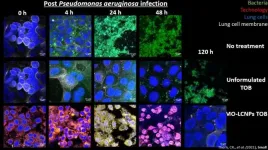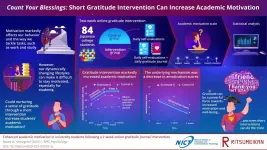(Press-News.org) The Indian public blamed foreigners, minority groups and doctors for the rapid spread of COVID-19 across the country during the first wave, due to misinformation, rumour and long-held discriminatory beliefs, according to an international study led by Monash University.
This resulted in people refusing to get tested for fear of humiliation or public reprisals, which included attacks on Muslims and health care workers.
However, when presented with accurate and reliable information about the virus spread, the Indian public back-pedalled on those negative sentiments and were more likely to get tested and seek medical help, highlighting the importance of health advice from credible sources.
A world-first study by researchers in the Monash Business School, Indian Institute of Technology Kanpur and University of Southampton found the prevalence of accurate information decreased the stigmatisation of COVID-19 patients and reduced the belief that infection was confined to religious minorities, lower-caste groups and frontline workers.
Led by Professor Asad Islam, Director of the Centre for Development Economics and Sustainability in the Monash Business School, the study surveyed 2,138 people across 40 localities in the Indian state of Uttar Pradesh on their views about spread of COVID-19.
Ninety-three per cent of respondents blamed foreigners for the spread of COVID-19, while 66 per cent also blamed the Muslim population. Surprisingly, 34 per cent and 29 per cent of people blamed health care workers and police respectively for failing to contain the virus spread.
The social and physical consequences of stigmatisation were found to be severe, as those with symptoms refused to step forward and get tested for fear of public humiliation.
Other examples included the refusal of non-Hindu doctors and patients to have a dignified burial; attacks on Muslims during and after religious events; health care workers being assaulted and asked to vacate their residences due to fear of virus spread; and incidents of COVID-19 patients leaving self-isolation early.
As India comes to grips with a devastating second wave, with an average of 350,000 new cases and 4,000 deaths daily, researchers say these incidents during the first wave are happening again.
"We believe the results are as relevant today, as widespread stigmatisation is visible even during this wave," Dr Islam said.
"Cases of stigmatisation during the second wave have resulted in doctors being verbally abused and prevented from taking a lift in their own residential flat, old parents being abandoned, several patients fleeing medical facilities across the country, and dead bodies being dumped in rivers.
"Most importantly, we found that stigmatisation of COVID-19 can have negative public health implications as it may lead people to avoid getting tested and respecting prevention measures. This is essential if India is to get on top of this second wave."
During the study, which took place in June 2020 at the height of the first wave, researchers surveyed individuals by phone and followed up with a randomised controlled test. The treatment group received information about COVID-19 and preventive strategies.
Researchers followed up with participants about one month later to assess if the information intervention was effective in improving knowledge about the transmission and prevention of COVID-19.
More than half of the participants who received the information brief were less likely to believe that any particular group was to be blamed for the spread of the disease and thus reduced stigmatisation of COVID-19 patients, frontline workers (health care workers, sanitary workers, and the police), and marginalised groups such as religious minorities.
Furthermore, researchers identified a significant increase in the self-reporting of COVID-related symptoms and subsequent medical treatment in the Indian population, including treatment for mental health. There was a 75 percentage point reduction in stress and anxiety experienced by participants in the treatment group.
An additional 10 per cent of participants reported a greater quality of life as a result of heightened information awareness and consumption.
"Health advice from credible sources in simple language is of utmost importance as individuals are still taking the pandemic lightly, not wearing their masks and are reluctant to get vaccinated due to widespread ignorance and misconception, even when the numbers are soaring," research co-author Associate Professor Liang Choon Wang from the Monash Business School's Department of Economics said.
"Raising awareness and reducing stress and stigmatisation could lead to encouraging vaccination rates, following prescribed quarantine or lockdown guidelines, coming forward and getting tested if symptoms are visible (or in early stages of infection) and getting help at the earliest time."
INFORMATION:
Professor Asad Islam (Monash Business School) led the study titled 'Stigma and Misconceptions in the Time of the COVID-19 Pandemic: A Field Experiment in India'.
Contributing authors of this research include Associate Professor Debayan Pakrashi (Indian Institute of Technology Kanpur), Professor Michael Vlassopoulos (University of Southampton), and Associate Professor Liang Choong Wang (Department of Economics, Monash University).
The study was supported by funding provided by the Centre for Development Economics and Sustainability (CDES), Monash University.
Please visit https://doi.org/10.1016/j.socscimed.2021.113966 for more information.
MEDIA ENQUIRIES
Leigh Dawson
T: +61 455 368 260 E: media@monash.edu
For more Monash media stories, visit our news and events site
World-first nanotechnology developed by the University of South Australia could change the lives of thousands of people living with cystic fibrosis (CF) as groundbreaking research shows it can improve the effectiveness of the CF antibiotic Tobramycin, increasing its efficacy by up to 100,000-fold.
The new technology uses a biomimetic nanostructured material to augment Tobramycin - the antibiotic prescribed to treat chronic Pseudomonas aeruginosa lung infections in severe cases of CF - eradicating the infection in as little as two doses.
In Australia, cystic fibrosis (CF) affects one in 2500 babies - or one baby born every four days - causing severe impairments to a person's ...
Cancer death rates have fallen dramatically in the United States, but factor in obesity, as researchers did at the University of North Carolina Gillings School of Global Public Health, and the picture changes.
In a study published May 10 in JAMA Network Open, researchers showed that obesity-related cancer deaths are improving, but at a slowing pace.
Based on mortality data for 50 million people, deaths from cancers not associated with obesity -- that's lung cancer and skin cancer, among others - are declining at a rate almost three times faster than cancers linked to obesity, such as stomach, colorectal, uterine, thyroid and postmenopausal breast cancer.
"These are cancers where we could see even larger mortality improvements with creative and practical tools to combat ...
Compared with the superresolution microscopy that bases on squeezing the point spread function in the spatial domain, the superresolution microscopy that broadens the detection range in the spatial frequency domain through the spatial-frequency-shift (SFS) effect shows intriguing advantages including large field of view, high speed, and good modularity, owing to its wide-field picture acquisition process and universal implementation without using special fluorophores labeling.
To enable spatial-frequency-shift microscopy with a superresolution at the subwavelength scale, it is essential to use the near-field evanescent wave with a larger wave vector than the far-field propagation wave for illumination, which can be built on the integrated photonics, paving the way for compact ...
Researchers from Tokyo Medical and Dental University (TMDU), collaborating with scientists from the Marine Biological Laboratory (MBL) and RIKEN, develop a novel technique for live-cell fluorescent imaging which leads them to discover a new actin structure in starfish early embryos.
Tokyo, Japan - Monitoring alignments of the building blocks of cells is important to understand how the cells are built. By collaborating with imaging scientists at the MBL, researchers from Japan have developed a new probe which they call POLArIS, allowing real-time imaging of molecular orientations in live cells.
A fluorophore emits polarized light as it glows. The orientation of polarized fluorescence ...
It is difficult for us to succeed in whatever we set out to do if we lack motivation. We usually need it as a driving force to achieve both short- and long-term goals, from household chores to getting a degree. However, because of the ongoing pandemic, our lifestyles have been subjected to drastic and dynamic changes, and many work- and study-related activities are now carried out online exclusively. This, among other complex factors, have made it difficult for some people to stay focused and motivated, and psychology researchers are trying to find effective and widely applicable solutions to address such problems.
In a END ...
COLUMBUS, Ohio - A new study's findings dispel the misconception that patients and providers are at high risk of catching COVID-19 at the dentist's office.
SARS-CoV-2 spreads mainly through respiratory droplets, and dental procedures are known to produce an abundance of aerosols - leading to fears that flying saliva during a cleaning or a restorative procedure could make the dentist's chair a high-transmission location.
Ohio State University researchers set out to determine whether saliva is the main source of the spray, collecting samples from personnel, equipment and other surfaces reached by aerosols during a range ...
Twenty-seven years ago, more than 1 million Rwandans were killed during the genocide against the Tutsi in Rwanda from April 7 to July 4, 1994. It is estimated that 100,000 to 250,000 women were raped during the 100-day genocide, and that 10,000 children were born as a result. A new study finds that Rwandans who were conceived by mothers who survived the 1994 genocide against the Tutsi have poorer adult health outcomes than those who were conceived by Rwandan mothers living outside the country at that time. In addition, those who were conceived through genocidal rape have poorer adult health ...
DALLAS, May 13, 2021 -- Higher body mass index (BMI) in adolescence is associated with a significantly higher risk of first ischemic stroke in adults under age 50 regardless of whether they had Type 2 diabetes, according to new research published today in Stroke, a journal of the American Stroke Association, a division of the American Heart Association.
While rates of adolescent obesity and stroke among adults under the age of 50 years continue to rise around the world, the precise link between the two conditions is still not fully understood.
"Adults who survive stroke earlier in life face poor functional outcomes, which can lead to unemployment, depression and anxiety," said study co-author Gilad Twig, M.D., M.P.H., Ph.D., an ...
It's a tough time to be a shark. Pollution, industrialized fishing, and climate change threaten marine life, and the populations of many top ocean predators have declined in recent years. In addition to studying sharks in the wild, scientists working to save sharks rely on ones living in zoos and aquariums so that they can help build breeding programs and learn more about the conditions sharks need to thrive. One important way the scientists do that is by playing matchmakers to the sharks, pairing up individuals in ways that increase genetic diversity. In a new study in Scientific Reports, scientists undertook the largest-ever effort to artificially inseminate sharks.Their work resulted in 97 new baby sharks, ...
Wild orangutans are known for their ability to survive food shortages, but scientists have made a surprising finding that highlights the need to protect the habitat of these critically endangered primates, which face rapid habitat destruction and threats linked to climate change.
Scientists found that the muscle mass of orangutans on the island of Borneo in Southeast Asia was significantly lower when less fruit was available. That's remarkable because orangutans are thought to be especially good at storing and using fat for energy, according a Rutgers-led study in the journal Scientific Reports.
The findings highlight ...




